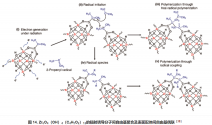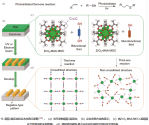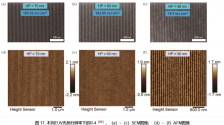You are using an out of date browser. It may not display this or other websites correctly.
You should upgrade or use an alternative browser.
You should upgrade or use an alternative browser.
Chinese semiconductor thread II
- Thread starter vincent
- Start date
Research progress and prospects of extreme ultraviolet photoresist
-Chemically Amplified Photoresist (CAR)
In 2024, Fu et al. From Shanghai University studied the microscopic process of photoacid generation by ionic PAGs used in EUV lithography and EBL. The results show that the quantum yield of photoacid in EUV lithography is closely related to the molecular structure of PAGs, and PAGs with different molecular structures may have different photoacid generation mechanisms. They systematically studied the detailed pathways of photoacid generation by ionic PAGs after attaching electrons in EUV lithography and EBL using density functional theory (DFT), and identified three pathways for photoacid generation.Figure 2As shown in (a), in pathway A, the tert-butyl group reacts with the photoacid anion and dissociates from the ionized photoresist, releasing CO 2 . Subsequently, the photoacid anion captures a proton from the tert-butyl cation radical to form photoacid and isobutylene.Figure 2As shown in (b), in route B, compared with route A, in addition to the photoacid anion forming a covalent bond with the isolated tert-butyl cation, the photoacid anion in the initial configuration is closer to the central carbon atom of the t -BOC protecting group.Figure 2As shown in (c), in pathway C, the photoacid anion directly captures a proton from the t -BOC group to form a photoacid and a neutral photoresist radical, and CO 2 is released from the photoresist radical. The overall reaction energy barrier in pathway A is the lowest and the initial configuration is the most favorable, so pathway A is the most likely pathway for proton transfer of the t -BOC group among the three pathways.
-Non-chemically amplified photoresist (n-CAR)
In 2023, Wang et al. reported two polystyrene (PSTS) photoresists with 50% and 70% sulfonium groups, respectively, denoted as PSTS 0.5 and PSTS 0.7 photoresists. Among them, PSTS 0.7 showed better EUV lithography performance. At a dose of 186 mJ/cm2, the limiting resolution and LER were 13 nm and 2.8 nm, respectively (Figure 5). The exposure mechanism of PSTS photoresist was studied by X-ray photoelectron spectroscopy (XPS), Fourier transform infrared spectroscopy (FTIR) and atomic force microscopy (AFM), and it was further confirmed that polar triflate and triphenylsulfonium groups decomposed into non-polar sulfides or polystyrene during exposure. In the same year, they designed and synthesized a class of functionalized bis(4-butoxyphenyl)sulfones (BPSS n , where n is the average number of triple sulfoniums per molecule, n = 2, 3, 4) containing different numbers of triphenylsulfonium (BPSS n , where n is the average number of triple sulfoniums per molecule, n = 2, 3, 4)Figure 6) [ ] . By controlling the average number of triphenylsulfonium groups in the molecule and optimizing the developer, BPSS4 exhibited a high resolution of 13 nm and a low line edge roughness of 2.5 nm in EUV patterning.

- Metal Oxide Cluster Photoresists.
in 2023, the research groups of Xu Hong and He Xiangming from Tsinghua University and the research group of Yasin Ekinci from the Paul Scherrer Institute in Switzerland jointly studied the exposure imaging mechanism of zirconium oxycarbon cluster-based photoresists containing olefins, and believed that two main reaction pathways may be involved (Fig.14), one is the surface charge polarity conversion caused by the dissociation of carboxylic acid ligands catalyzed by photoacids, and the other is the polymerization of free radical fragments generated under radiation.

In 2023, the research group of Xu Hong and He Xiangming from Tsinghua University introduced a click lithography strategy for ultra-efficient nanofabrication using a fast thiol-ene click reaction (Fig.15). The highest sensitivity in deep ultraviolet lithography was 7.5 mJ/cm 2 , which is 1/20~1/10 lower than the exposure dose required by the PAG-based photoresist system. At the same time, dense patterns with a line width of 45 nm were obtained by low-dose electron beam lithography of 10~40 mJ/cm 2 , indicating that the system has high-resolution lithography capabilities.

In 2024, Xiaojun Peng’s research group at Dalian University of Technology first proposed a C-F bond cross-linking strategy in the photolithography patterning process of zinc oxide clusters (Fig.16). The selected Zn–TBA cluster [TBA is 4-(trifluoromethyl)benzoic acid] is simple to prepare, has better solubility and film-forming ability than previously reported zinc oxide clusters, and can be stored at room temperature and in bright environments.


In 2024, Xiaojun Peng’s research group at Dalian University of Technology first proposed a C-F bond cross-linking strategy in the photolithography patterning process of zinc oxide clusters (Fig.16). The selected Zn–TBA cluster [TBA is 4-(trifluoromethyl)benzoic acid] is simple to prepare, has better solubility and film-forming ability than previously reported zinc oxide clusters, and can be stored at room temperature and in bright environments.

Since the mid 2010sThe fact that china is developing EUV photoresists means that they at least have a prototype machine of some sort right?
Looks like the focus is on end user products?To everyone's disappointment,huawei did not reveal Ascend 910c or any other AI chips at this latest conference
I don't know why anyone would expect AI chip to be announced at a consumer product event.
anyhow.
Loongson 3B6600 desktop CPU expect to tape out next year and this 8 core CPU expect single/multi core performance to be similar to intel 12-13th generation level. 3B6600 expects to be 3.0GHz and integrated with LG200 GPU. Uses 8 LA864 core
Says here that LS now support windows emulator and will test Android emulator next year
anyhow.
Loongson 3B6600 desktop CPU expect to tape out next year and this 8 core CPU expect single/multi core performance to be similar to intel 12-13th generation level. 3B6600 expects to be 3.0GHz and integrated with LG200 GPU. Uses 8 LA864 core
Says here that LS now support windows emulator and will test Android emulator next year
Loongson's 9A1000 GPU has 32 TOPS AI accelerator.
It's working on 9A2000 GPU whose performance should be 8 to 10x that of 9a1000, similar in performance to RTX 2080.
I still thinking this is mostly just to integrate with their CPU to improve desktop performance. It's impressive how much Loongson is willing to do this on their own when they are this far behind.
To everyone's disappointment,huawei did not reveal Ascend 910c or any other AI chips at this latest conference
I don't think the "everyone" is anyone who was actually at the conference.
The Mate XT was front and center and is marketed as the most advanced phone in the world, the only tri-fold, at the cost of nearly $3000. Then the Huawei Aito M9 and ADAS 3.0 billed as direct competition to Tesla and having better autonomous abilities.
So why would "everyone" be disappointed in this scenario?
You are doing the Western "at what cost?" strategy of finding something remotely negative in an event you are afraid would be seen as too positive.
Semiconductor equipment manufacturer Silicon Cool Technology received strategic financing of RMB 100 million
Zhuhai Silicon Cool Technology Co., Ltd. (abbreviated as: Silicon Cool Technology) recently completed a strategic financing of 100 million yuan. This round of financing was led by CRRC Capital, Woniu Capital (a fund of Huichuan executives), and Wenxin Fund (a subsidiary fund of listed company Wingtech Technology). The funds will be used to increase the mass delivery of silicon carbide pre-sintering bonding equipment and the commercialization of advanced packaging HBM equipment .
Founded in 2018, Silicon Cool Technology Co., Ltd. is a technology company focusing on the research and development and manufacturing of intelligent high-speed, high-precision bonding equipment. It is committed to providing high-precision manufacturing equipment for cutting-edge industries such as new energy, artificial intelligence, and semiconductors. Its core products include fully automatic pre-sintering equipment, fully automatic IGBT module mounting equipment, fully automatic high-precision bonding equipment, and fully automatic camera module bonding equipment.

